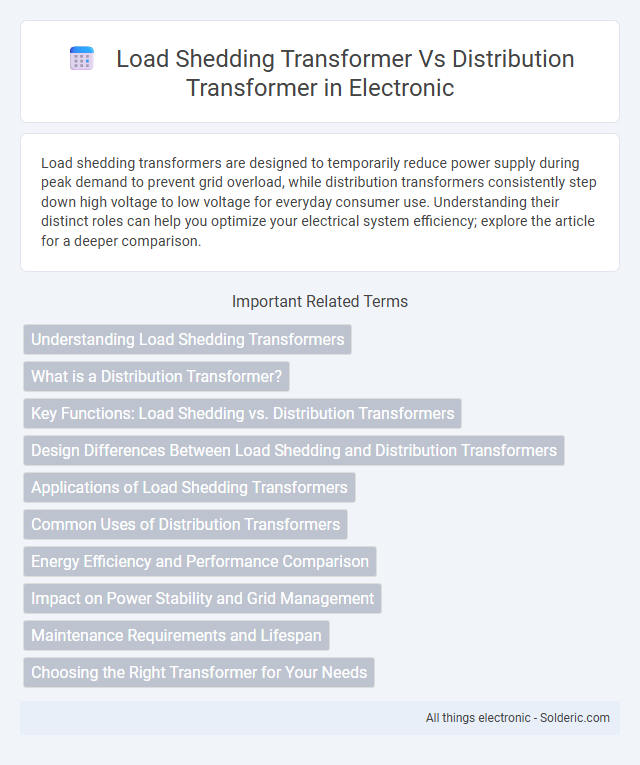Load shedding transformers are designed to temporarily reduce power supply during peak demand to prevent grid overload, while distribution transformers consistently step down high voltage to low voltage for everyday consumer use. Understanding their distinct roles can help you optimize your electrical system efficiency; explore the article for a deeper comparison.
Comparison Table
| Feature | Load Shedding Transformer | Distribution Transformer |
|---|---|---|
| Purpose | Temporary power reduction during peak demand | Permanent voltage step-down for distribution |
| Operation | Intermittent, controlled load reduction | Continuous power supply |
| Design | Supports load interruptions; rugged design | Designed for steady, reliable voltage transformation |
| Voltage Regulation | May allow voltage drop during load shedding | Maintains stable voltage levels |
| Application | Used in emergency or peak load management | Used for local electric power distribution |
| Load Handling | Handles variable, interrupted load | Handles consistent load over time |
| Typical Installation | At substations or grid level | Near residential or commercial areas |
Understanding Load Shedding Transformers
Load shedding transformers are designed to manage and reduce electrical load during peak demand periods, ensuring system stability and preventing blackouts. Unlike distribution transformers, which primarily step down voltage for general consumer use, load shedding transformers actively participate in load management by selectively disconnecting or reducing power to specific areas. Understanding your load shedding transformer's role helps optimize energy distribution and enhances the reliability of the electrical grid during high demand.
What is a Distribution Transformer?
A distribution transformer is an electrical device designed to step down high voltage electricity from the distribution line to a lower voltage suitable for residential or commercial use. It ensures efficient delivery of power to end-users by converting voltage levels to meet local requirements. Your electrical system relies on distribution transformers to provide safe, stable, and reliable energy for everyday appliances and devices.
Key Functions: Load Shedding vs. Distribution Transformers
Load shedding transformers primarily manage and regulate electrical load by disconnecting non-essential circuits during peak demand to prevent grid overload. Distribution transformers, in contrast, step down high voltage from the power grid to usable lower voltage levels for residential and commercial consumption. Both transformers play crucial roles in ensuring electrical system reliability and efficiency, with load shedding transformers focusing on demand management and distribution transformers on voltage conversion.
Design Differences Between Load Shedding and Distribution Transformers
Load shedding transformers are designed with enhanced thermal protection and tap-changing capabilities to manage sudden load fluctuations and prevent system overloads, whereas distribution transformers prioritize efficient voltage regulation for steady, continuous power delivery to end-users. Load shedding transformers often feature robust insulation and cooling systems to handle intermittent high loads, while distribution transformers are optimized for minimal losses during consistent load conditions. The core construction and winding configurations differ to accommodate the specific operational requirements of load shedding transformers versus distribution transformers.
Applications of Load Shedding Transformers
Load shedding transformers are primarily used in power systems to manage and reduce load during peak demand or fault conditions, ensuring system stability and preventing blackout scenarios. These transformers facilitate selective disconnection of non-critical loads while maintaining essential services, commonly deployed in industrial plants, utility substations, and large commercial facilities. Their application enhances grid reliability and operational efficiency by dynamically balancing power distribution without affecting critical infrastructure supported by distribution transformers.
Common Uses of Distribution Transformers
Distribution transformers are primarily used to step down voltage from the primary distribution lines to a level suitable for residential, commercial, and light industrial consumption, making them essential components in power supply networks. They are commonly installed on poles or pads near end-users to provide reliable electricity for homes, offices, and small businesses. You rely on distribution transformers to ensure safe and efficient voltage delivery tailored to daily consumer needs.
Energy Efficiency and Performance Comparison
Load shedding transformers are specifically designed to handle variable loads efficiently by minimizing energy losses during peak demand periods, whereas distribution transformers focus on stable, consistent energy delivery to end-users. The energy efficiency of load shedding transformers exceeds that of traditional distribution transformers by incorporating advanced core materials and optimized winding designs to reduce no-load losses. Your choice between these transformers should consider performance under fluctuating loads and energy savings potential to enhance overall grid reliability.
Impact on Power Stability and Grid Management
Load shedding transformers temporarily reduce power supply during peak demand to prevent grid overload, directly enhancing power stability by managing load distribution. Distribution transformers maintain consistent voltage levels for end users, supporting reliable energy delivery across the network. Your choice between these transformers affects the efficiency of grid management and the stability of the power system during fluctuating demand.
Maintenance Requirements and Lifespan
Load shedding transformers require frequent maintenance to handle fluctuating loads and prevent overheating, which can significantly reduce their operational lifespan compared to distribution transformers. Distribution transformers benefit from more stable operating conditions, resulting in lower maintenance costs and extended service life, often exceeding 20-30 years with proper care. Regular inspections, oil testing, and cooling system checks are essential for both types but are more critical for load shedding transformers to ensure reliability and longevity.
Choosing the Right Transformer for Your Needs
Load shedding transformers are designed to handle intermittent power demands and protect the electrical system during peak load reductions, while distribution transformers primarily step down voltage for consistent power delivery across residential or commercial networks. Your choice depends on whether you need a reliable solution for managing energy loads dynamically or a steady transformer for distributing electricity efficiently. Opting for the right transformer ensures optimal performance, energy savings, and extends the lifespan of your electrical infrastructure.
load shedding transformer vs distribution transformer Infographic

 solderic.com
solderic.com